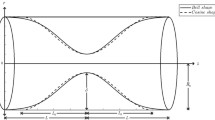Abstract
An approximate solution is presented to the problem of incompressible flow through an axisymmetric constriction. The geometry is intended to simulate an arterial stenosis, and the solution is applicable to both mild and severe stenoses for Reynolds numbers below transition. Theoretical results obtained for specific geometries are given for the velocity distribution, pressure drop, wall shearing stress, and separation phenomena. These results reveal the significant alterations in flow caused by a stenosis. Experiments using model stenoses are described and compared with the theoretical results. Theoretical predictions of pressure drop and separation characteristics are in reasonably good agreement with the experimental observations.
Similar content being viewed by others
Literature
Caro, C. G., J. M. Fitz-Gerald and R. C. Schroter. 1971. “Atheroma and Arterial Wall Shear—Observation, Correlation and Proposal of a Shear Dependent Mass Transfer Mechanism for Atherogenesis.”Proc. Roy. Soc. Lond. B.,177, 109–159.
Eklof, B. and S. I. Schwartz. 1970. “Critical Stenosis of the Carotid Artery in the Dog.”Scand. J. Clin. Lab. Invest.,25, 349–353.
Forrester, J. H. and D. F. Young. 1970. “Flow Through a Converging-Diverging Tube and Its Implications in Occlusive Vascular Disease.”J. Biochem.,3, 297–316.
Fry, D. L. 1968. “Acute Vascular Endothelial Changes Associated with Increased Blood Velocity Gradients.”Circulation Res.,22, 165–197.
Lee, J. S. and Y. C. Fung. 1970. “Flow in Locally Constricted Tubes at Low Reynolds Numbers.”J. Appl. Mech.,37, 9–16.
May, A. G., J. A. DeWeese and C. G. Rob. 1963. “Hemodynamic Effects of Arterial Stenosis.”Surgery,53, 513–524.
Merrill, E. W. 1965. “Rheology of Human Blood and Some Speculations on Its Role in Vascular Homeostasis.” InBiophysical Mechanisms in Vascular Homeostasis and Intravascular Thrombosis, Sawyer, P. N., ed. New York: Appleton-Century-Croft.
Texon, M. 1963. “The Role of Vascular Dynamics in the Development of Atherosclerosis.” InAtherosclerosis and Its Origin, Sandler, M., and G. H. Bourne, eds. New York: Academic Press.
Wesolowski, S. A., C. C. Fries, A. M. Sabina and P. N. Sawyer. 1965. “Turbulence, Internal Injury and Atherosclerosis.” InMechanisms in Vascular Homeostasis and Intravascular Thrombosis, Sawyer, P. N., ed. New York: Appleton-Century-Croft.
Young, D. F. 1968. “Effect of a Time-Dependent Stenosis on Flow Through a Tube.”J. Engng Ind., Trans. Am. Soc. Mech. Engrs.,90, 248–254.
Author information
Authors and Affiliations
Rights and permissions
About this article
Cite this article
Morgan, B.E., Young, D.F. An intergral method for the analysis of flow in arterial stenoses. Bltn Mathcal Biology 36, 39–53 (1974). https://doi.org/10.1007/BF02461189
Received:
Issue Date:
DOI: https://doi.org/10.1007/BF02461189




